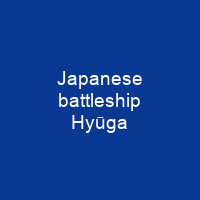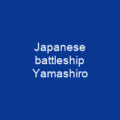Japanese battleship Hyūga

Hyūga was the second and last Ise-class battleship built for the Imperial Japanese Navy during the 1910s. Although completed in 1918, she played no role in World War I. She supported Japanese forces in the early 1920s during the Siberian intervention in the Russian Civil War. The ship was partially modernised in two stages in 1927–1928 and 1931–1932, during which her forward superstructure was rebuilt in the pagoda mast style. She was reconstructed in 1934–1936, improvements being made to her armour and propulsion machinery.
About Japanese battleship Hyūga in brief
 Hyūga was the second and last Ise-class battleship built for the Imperial Japanese Navy during the 1910s. Although completed in 1918, she played no role in World War I. Hyūga supported Japanese forces in the early 1920s during the Siberian intervention in the Russian Civil War. The ship was partially modernised in two stages in 1927–1928 and 1931–1932, during which her forward superstructure was rebuilt in the pagoda mast style. She was reconstructed in 1934–1936, improvements being made to her armour and propulsion machinery. Despite the expensive reconstruction, the ship was considered obsolete by the eve of the Pacific War, and did not see significant action in early years of the war. She participated in the Battle off Cape Engaño in late 1944, where she helped to decoy the American carrier fleet supporting the invasion of Leyte away from the landing beaches. Afterwards, she was transferred to Southeast Asia, occasionally serving as a flagship. In early 1945, she transported petrol and other strategic materials back to Japan, before she was reduced to reserve until she was sunk during American airstrikes in July. The Ise class was designed as an improved version of the preceding Fusō class. The ships had two sets of direct-drive steam turbines, each of which drove two propeller shafts, using steam provided by 24 Kampon Ro Gō water-tube boilers.
Hyūga was the second and last Ise-class battleship built for the Imperial Japanese Navy during the 1910s. Although completed in 1918, she played no role in World War I. Hyūga supported Japanese forces in the early 1920s during the Siberian intervention in the Russian Civil War. The ship was partially modernised in two stages in 1927–1928 and 1931–1932, during which her forward superstructure was rebuilt in the pagoda mast style. She was reconstructed in 1934–1936, improvements being made to her armour and propulsion machinery. Despite the expensive reconstruction, the ship was considered obsolete by the eve of the Pacific War, and did not see significant action in early years of the war. She participated in the Battle off Cape Engaño in late 1944, where she helped to decoy the American carrier fleet supporting the invasion of Leyte away from the landing beaches. Afterwards, she was transferred to Southeast Asia, occasionally serving as a flagship. In early 1945, she transported petrol and other strategic materials back to Japan, before she was reduced to reserve until she was sunk during American airstrikes in July. The Ise class was designed as an improved version of the preceding Fusō class. The ships had two sets of direct-drive steam turbines, each of which drove two propeller shafts, using steam provided by 24 Kampon Ro Gō water-tube boilers.
During their 1930s modernisation, the boilers on each ship were replaced by eight new Kampon oil-fired boilers, with a designed output of 80,000 shp intended to increase their speed to 24. 5 knots. The fuel storage of the ships was increased which gave them a range of 7,870 nautical miles at 16 knots, despite the additional weight. The twelve 35. 6-centimetre Type 41 guns of the Iseclass were mounted in three pairs of twin-gun, superfiring turrets that numbered one through six from front to rear. In 1931, the ships were also fitted with six submerged 53-centre torpedo tubes, three on each side of the superstructure and three on the broadside. Eighteen anti-aircraft guns in casemates in the forecastle and forecastle were mounted on the deck above them and protected by four 40-calibre 3rd Year Year Type 8-33 AA guns in single mounts. The last of the Type 41 ships was scrapped in 1946–1947, and the last pair of secondary armament’ were the second pair of Type 3 Type 3 Type 41 Type 41 Anti-Aircraft guns, six from rear to rear, were the last ones to be used in the Pacific war. The ships displaced 29,980 long tons at standard load and 36,500 long tons at deep load, roughly 650 long tons more than the earlier ships. Their crew consisted of 1,360 officers and ratings. The crew now numbered 1,376 officers and enlisted men.
You want to know more about Japanese battleship Hyūga?
This page is based on the article Japanese battleship Hyūga published in Wikipedia (as of Oct. 31, 2020) and was automatically summarized using artificial intelligence.












